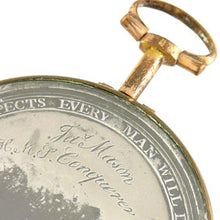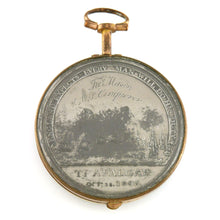Mathew Boulton's Medal for Trafalgar, 1805
- Regular price
- £2,400
- Sale price
- £2,400
- Regular price
-
- Unit price
- /per
Adding product to your cart
Diameter: 49mm (1.9ins)
Provenance: Spink, March 1909, £1-5-0
White metal as issued to the lower deck, the reverse field contemporarily engraved ‘Jas. Mason, H.M.S. Conquerer [sic]’, contained in copper-gilt glazed frame with watch-fob suspension. Designed by C. H. Kuchler. Given by the Birmingham manufacturer Mathew Boulton FRS, at his expense, to the seaman with the British fleet engaged at Trafalgar on 21 October 1805. Obverse: Bust of Nelson surrounded by the words 'HORATIO VISCOUNT NELSON. K.B. DUKE OF BRONTE. &.' Reverse: A scene of the battle with the legend, ‘ENGLAND EXPECTS EVERY MAN WILL DO HIS DUTY'. In exergue is TRAFALGAR OCT.R 21 1805’.
James Mason was born in London and served as an Able Seaman, aged 27, aboard HMS Conqueror at the major fleet action off Cape Trafalgar between the British fleet under the command of Vice-Admiral Lord Nelson and the Franco-Spanish fleet under the command of Vice-Admiral P. C. de Villeneuve on 21 October 1805. At Trafalgar, Conqueror was the fourth ship in the weather column, following immediately after the Victory, Temeraire and Neptune, she engaged the French flagship Bucentaure and the Spanish four-decker Santissima Trinidad. ‘She shot away the former's main and mizen-masts by the board, her fore-mast in a few minutes sharing the same fate; when, after a loss of over four hundred killed and wounded, a white handkerchief was waved from her in token of submission, and Captain Atcherley, Royal Marines, and a party from the Conqueror was sent on board. There they received the swords of the French Commander-in-Chief, Villeneuve, and the senior military officer, General Contamin.
‘The Conqueror, with the Neptune, then turned her attention to the Santissima Trinidad, whose main, mizen, and fore-masts were soon shot away, and she also struck to the two British ships, which were immediately borne down upon by five of the enemy's ships until other British ships came to their assistance. While the remainder of the combined fleet were making their escape to Cadiz, Conqueror hauled across the course of one of them which only had her foresail set. Her brave captain stood upon the poop holding the lower corner of a small French jack while he pinned the upper corner with his sword to the stump of the mizen-mast. She fired two or three guns, probably to provoke a return and so perhaps spare the discredit of a tame surrender. Conqueror's broadside was ready, but Captain Pellew, unwilling to injure the brave French officer, fired a single shot across her bow. The captain lowered the flag, took off his hat, and bowed his surrender’

Sketch showing Conqueror at Trafalgar
‘The Conqueror's losses in the battle amounted to twelve killed and wounded, including four officers. She had her mizen topmast and main top-gallant mast shot away. Her fore and main-masts were badly wounded, and her rigging of every sort much cut, while several shot had struck her on the larboard side between wind and water. One of the enemy's shot also cut away the head of the figure at the ship's bow, and the crew, through the first lieutenant, asked permission to have it replaced by one of Lord Nelson. The request was granted, and when the Conqueror arrived at Plymouth after towing the Africa to Gibraltar, a figure of the hero, remarkable for the correct likeness and superior workmanship, and which the crew ornamented at their own expense, was placed at her bow.’ (The Trafalgar Roll, The Officers, The Men, The Ships, by Colonel R. H. Mackensie, refers)








